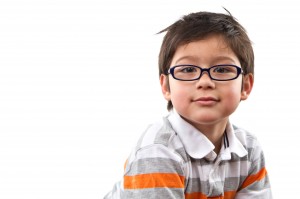By Smarty Guest Blogger Elliot McKee, MD, Ophthalmologist, Comprehensive Pediatric Ophthalmologist and Pediatric and Adult Strabismus, Charlotte Eye Ear Nose & Throat Associates, P.A., Belmont, SouthPark and Statesville Office
All children should have their vision checked at their pediatrician’s office during a check-up, starting at age 5 years. If signs of any problem are noted, your pediatrician will refer you to a pediatric ophthalmologist for a more detailed eye exam. Thankfully, not all children referred to the ophthalmologist have a serious eye problem, as some are easily correctable or are more related to behavior rather than vision. Sometimes there are serious eye conditions that have escaped detection until that time, particularly if the condition only affects one eye. Having a complete eye exam is important, because many childhood vision problems can be corrected with timely treatment and the benefits of clear vision are lifelong.
Parents are often surprised at how much can be learned about a child’s vision just by seeing how the child reacts to interesting toys and the parent’s or examiner’s face. The ophthalmologist will try to determine how well the child sees with each eye, how well the eyes move, and if the eyes are able to work together.
For preschool-age children, vision is checked by showing pictures on an eye chart about 20 feet away. If a child is shy, or just learning the names of objects, a card can be given to the child that allows him or her to simply point to the correct picture. Older children can read letters on an eye chart in much the same way as adults.
Eyedrops are always given to dilate the child’s pupils and allow the ophthalmologist to examine the back part of the eye. Although the eyedrops are not painful, many children are anxious about receiving them. It takes about 30 minutes after instillation of the eyedrops for them to fully take effect and allow for the completion of the exam. The eyedrops used in my clinic are very effective and typically wear off after 12-18 hours. This is not harmful to a child’s eyes, although sunglasses may be worn after the exam if it is a sunny day.
Once the child’s eyes are dilated, the ophthalmologist can determine if the child’s vision is in focus by using a hand-held light and lenses held in front of the child’s eye. When the ophthalmologist does this, he is looking for the “red reflex”, which is the red light sometimes seen in the center of the eye in a photograph taken with a flash. This will allow the ophthalmologist to know if the child needs glasses. Most young children are slightly far-sighted and do not need glasses. Although only a few infants and toddlers need glasses, the reasons for wearing them are very important and cannot be ignored. Many school-age children need glasses to see their teacher clearly and help improve school performance.
About 2-5% of children have a condition called amblyopia (or “lazy eye”), where good vision development did not occur. This is usually because one eye needs glasses more than the other. It can often be corrected just be wearing the proper prescription glasses, but sometime more treatment is necessary, such as covering the better-seeing eye with a patch or blurring its vision with dilating eyedrops.
Some children have a condition where the eyes are not aligned together. This is called strabismus. In this condition, one or both eyes may drift in toward the nose, out toward the ear, or even up or down. When this occurs, the child is not able to use the two eyes together and one of the eyes may lose vision due to amblyopia. This can be corrected with glasses most of the time, but sometimes surgery may be needed to re-balance the eye movements.
To schedule an appointment with Dr. McKee or any of our Board Certified physicians, please call 704-295-3000 or visit goodsenses.com for more information on our services.
![]()
Charlotte Eye Ear Nose & Throat Associates

704-295-3000
Click here for locations.
You can find CEENTA on facebook, twitter, blog & youtube.


